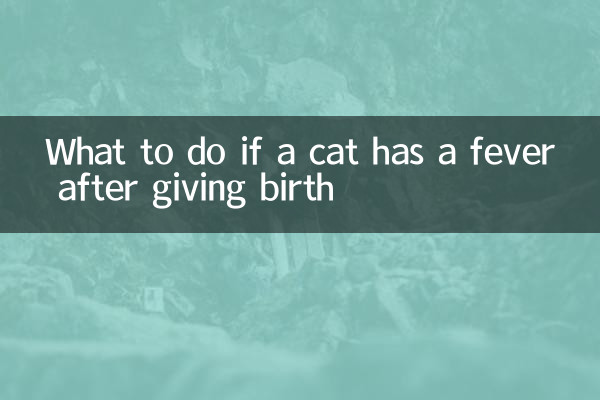What to do if a cat has a fever after giving birth
Postpartum care for a cat mother is a process that requires special attention, especially when the cat develops postpartum fever, timely measures need to be taken. This article will combine the hot topics and hot content on the Internet in the past 10 days to give you a detailed introduction to the causes, symptoms, coping methods and preventive measures of postpartum fever in cats.
1. Common causes of postpartum fever in cats

Postpartum fever in cats is usually caused by:
| Reason | Description |
|---|---|
| birth canal infection | The birth canal can become infected with bacteria during delivery, causing inflammation and fever. |
| Mastitis | Milk stasis or bacterial infection causes inflammation of the breast glands, which can be accompanied by fever. |
| endometritis | Retained placenta or bacterial infection triggers inflammation of the uterus, causing an increase in body temperature. |
| stress response | After giving birth, the mother cat's body is weak and her immunity is easily reduced due to stress. |
2. Symptoms of postpartum fever in cats
If your mother cat has the following symptoms, it may be a sign that she has a fever:
| Symptoms | Detailed performance |
|---|---|
| Increased body temperature | Normal cat body temperature is 38-39°C. If it exceeds 39.5°C, you need to be vigilant. |
| Loss of appetite | Refusing to eat or drinking significantly less water. |
| listless | Reduced activity, appearing tired or listless. |
| Shortness of breath | The respiratory rate increases and may be accompanied by wheezing. |
| Breast redness and swelling | The breast area is warm, swollen, or tender. |
3. How to deal with postpartum fever in cats
If a mother cat is found to have a fever after giving birth, the following measures can be taken:
| steps | Specific operations |
|---|---|
| Measure body temperature | Use a pet-specific thermometer to measure your rectal temperature to confirm whether you have a fever. |
| Keep the environment comfortable | Provide a quiet, warm environment to prevent mother cats from getting cold or frightened. |
| hydration | Encourage mother cats to drink plenty of water to prevent dehydration. |
| Seek medical treatment | If your body temperature continues to be higher than 39.5°C or your symptoms worsen, you need to seek medical attention immediately. |
4. Measures to prevent postpartum fever in cats
In order to reduce the risk of cats having postpartum fever, the following preventive measures can be taken in advance:
| Precautions | Specific methods |
|---|---|
| Maintain hygiene in the delivery room | Clean the delivery room regularly and replace clean bedding to avoid bacterial growth. |
| Eat properly | Provide highly nutritious food to enhance mother cat's immunity. |
| Regular inspection | Observe the mother cat's physical condition regularly after giving birth to detect abnormalities in time. |
| Avoid excessive distractions | Reduce external interference and allow mother cats to rest in peace. |
5. Popular topics and user concerns
According to the data analysis of the entire network in the past 10 days, the following are the hot topics and user concerns about cat postpartum care:
| hot topics | User concerns |
|---|---|
| cat postpartum diet | How to provide a nutritionally balanced postpartum meal for a mother cat. |
| Postpartum infection prevention | How to prevent postpartum infections in mother cats. |
| kitten care | How to ensure kittens are well taken care of when their mother cat is sick. |
| Veterinarian Recommended Medications | Which medications are safe to use to treat postpartum fever in cats? |
Summary
Postpartum fever in cats is a problem that needs to be dealt with promptly. Cat owners should pay close attention to the physical condition of their mothers and take action as soon as possible when abnormalities are discovered. Through reasonable prevention and scientific care, the risk of postpartum fever in cats can be effectively reduced and the health of mother cats and kittens can be ensured. If symptoms are severe, be sure to contact your veterinarian promptly to avoid delays in treatment.

check the details

check the details